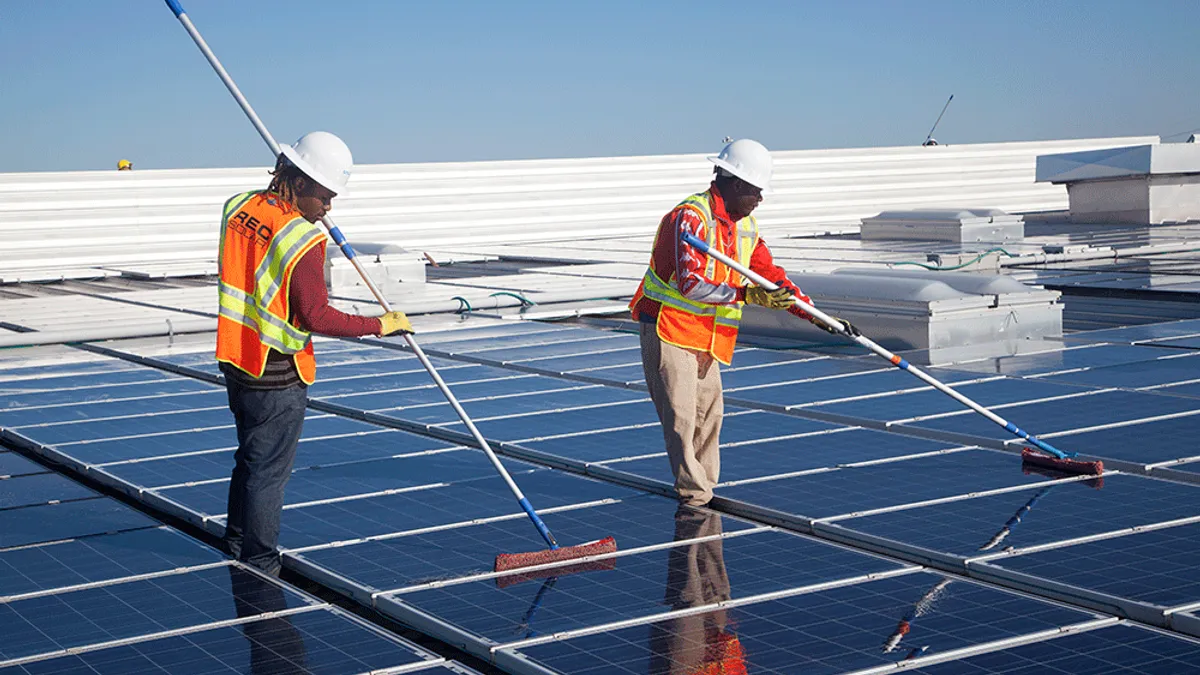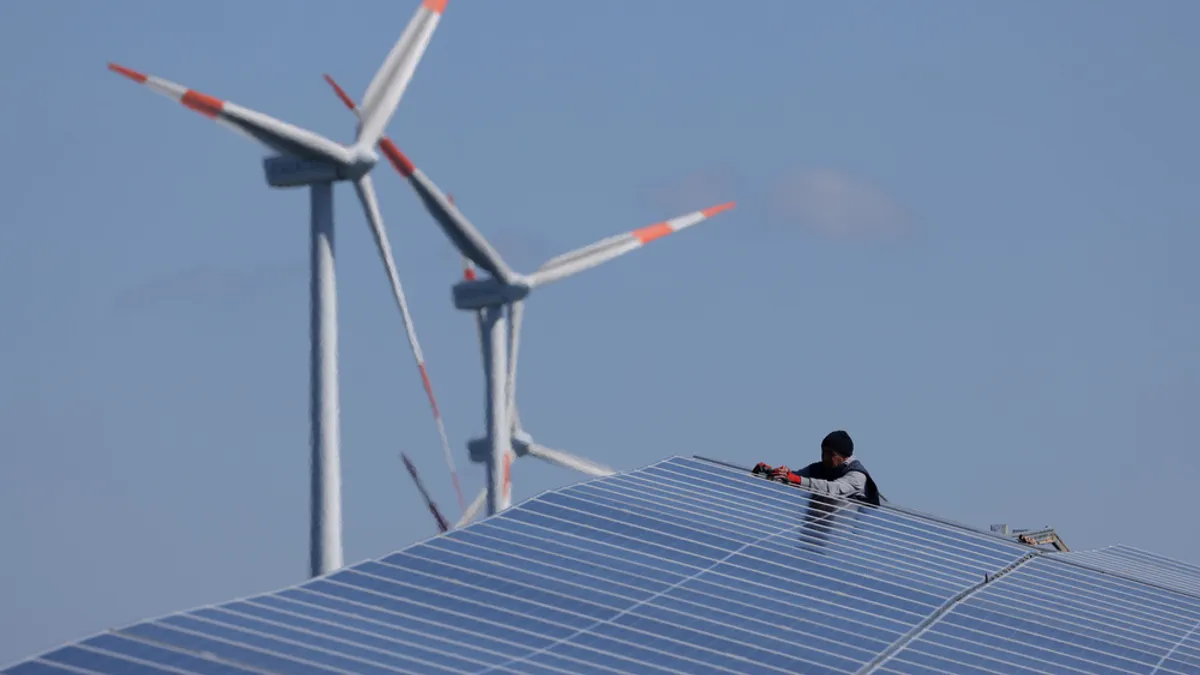Only a nascent solar market less than two years ago, debates in Nevada over net metering policies have captured the attention of utilities and renewable energy advocates nationwide at the beginning of 2016.
At the end of December, utility regulators issued a decision calling for reforms to solar net metering and utility rate practices. The key provisions are higher basic service charges for rooftop solar customers and a significant reduction in the value net energy metering credits solar customers receive for power their arrays send back to the grid.
But more dramatic than the changes in charges and net metering rates in the order was the ruling that they would apply not just to new solar systems, but to existing ones as well. Both solar advocates and NV Energy want that provision changed, and a hearing has been scheduled for the beginning of next month.
The new rates will significantly diminish the value proposition for rooftop solar systems, industry leaders say, and major installers SolarCity and Sunrun announced they would pull out of the state market after the decision. But as solar advocates gear up to testify for the inclusion of grandfathering in hearings next month, some Nevada stakeholders say their previous lobbying efforts may have sown the seeds for the entire controversy.
Grandfathering controversy
In declining to “grandfather” in existing solar systems, critics of the decision say regulators may have violated the contracts clause of the U.S. Constitution by undermining the value proposition of legally-binding leasing agreements between solar customers and installers of third party owned (TPO) solar.
“I know of no other net energy metering ruling that did not grandfather existing systems,” said North Carolina Clean Energy Technology Center Policy Analyst Benjamin Inskeep, who studies and chronicles solar policy. “As far as I know, this is the first time it has happened.”
Jim Lazar, a principal at the Regulatory Assistance Project, and Adam Browning, executive director of the solar advocacy group VoteSolar, agreed with Inskeep, saying they had never seen a similar net metering ruling without a grandfathering provision. Kevin Fox of the law firm Keyes, Fox & Weidman echoed their observations.
“The amount and length of grandfathering has been variable, but this is a first for offering none,” Fox told Utility Dive.
But as dramatic as the lack of grandfathering is, it is not final. On Jan. 20, commissioners filed a draft order accepting a request from the Nevada Bureau of Consumer Protection to hear testimony on the grandfathering provision, which the BCP labeled, “unjust, unreasonable, or unjustly discriminatory.”
While the commission still sees “inadequate evidence” for the inclusion of grandfathering, according to Commissioner David Noble’s filing, “all parties will be given an opportunity to provide supplemental direct testimony” in the hearing, slated for Feb. 8.
NV Energy, in a surprise move on Monday, petitioned regulators to instate a grandfathering provision when they rehear the case, even though it would leave the utility paying more for solar from the existing systems.
The road to net metering reform
SolarCity, the nation’s leading rooftop solar installer, expanded to Nevada in 2013 with financial backing from the Office of Economic Development’s Catalyst Fund.
The initial expectation was for 100 SolarCity jobs, CEO Lyndon Rive said at the time. “But a sustainable local solar industry could create thousands of jobs. We hope to partner with the state and industry to create the business and regulatory certainty that can pave the way for a thriving local solar economy.”
Through 2015, “SolarCity met and exceeded all their goals,” said former PUCN Commissioner Rose McKinney-James, now a managing principal of Energy Works Consulting. Other major national solar installers followed excitedly into a state with some of the best solar PV potential — in terms of overall sunlight — in the nation.
Nevada is a prime example of a market where demand for residential solar surged with the affordability provided by third party ownership (TPO) offerings, according to GTM Research Senior Solar Analyst Cory Honeyman.
“[Nevada] jumped from the 14th-biggest residential solar market in 2014 to 2015’s second-biggest state market,” Honeyman said.
The rapid 2015 growth pushed the state quickly to a 235 MW cap on net metered systems imposed by Senate Bill 374 — legislation signed in May of that year that gave PUCN the authority to regulate net metering rates.
While the first set of solar remuneration rates, dubbed “NEM1” by lawmakers, was set at the retail rate of electricity, the legislation also directed regulators to establish an “NEM2” tariff by the end of the year that would address the remuneration debate between the utility and solar installers.
Debate between the two sides began with the fight over SB 374 in the spring of last year and continued through commission hearings in August on what to do about the rapidly approaching cap.
At the end of August, as the state hit the NEM1 cap, regulators devised a stopgap measure: They would extend retail rate net metering, but only until the end of the year. That set the stage for the controversial rulings to come.
On Dec. 23, the commission delivered its decision.
“Current rates for NEM ratepayers are not properly aligned with the costs to serve NEM ratepayers,” the regulators wrote in docket 15-07041. “As NEM system penetration increases, the cost-shift will grow.”
The new rates
The new rates will increase the monthly charges for NV Energy customers with rooftop solar from the $12.75 to $17.90, while the volumetric rate will fall from $0.111/kWh to $0.108/kWh. The NEM credit for present and future solar owners would fall from $0.11/kWh — roughly the retail rate of electricity — to $0.09/kWh in the first year.
Implemented through what the ruling termed “gradualism,” the numbers will finally reach $38.51 per month for the basic charge and a $0.099/kWh volumetric rate at the end of a five year phase in. The NEM credit for present and future solar owners would, over five years, fall to $0.026/kWh in 2020. Time of use rates will also be introduced for customers.
“I have to wonder how you navigate the contractual aspects of this decision,” McKinney-James said.
“As a solar owner, I am concerned about the change in the credit rates but customers with third-party leasing company contracts rely on those economics,” the former commissioner said. “That is the vast majority of the new customers. That aspect of this decision is challengeable.”
Democratic State Senate Minority Leader Aaron D. Ford, who was one of the first Nevada lawmakers to ask the commission for a now-denied stay of its decision, agreed.
“Negative impacts on the solar industry like companies closing down and jobs being lost were not the intent of the legislation that put this decision before the PUCN,” he said. They will have to go through the legal process, but administrative matters are appealable and I think this is going to court.”
Agency decisions are typically accorded deference on appeal to the judicial system, Brian Nese, a partner at the law firm Stoel Rives told Utility Dive.
“The standard for a challenge is very high,” he said. “That said, there may be grounds here.”
A ‘punitive’ ruling?
NV Energy delivered the specific tariffs Dec. 30, as required by the commission’s Dec. 23 order. But according to a company spokesperson, the idea to make them apply to existing systems did not come from the utility.
NV Energy "did not propose to discontinue net metering for existing rooftop solar customers,” said Mark Severts, project communications director for the utility.
That part of the ruling originated with the regulatory staff, an independent party in proceedings, according to PUCN Public Information Officer Peter Kostes.
“The Commission accepted regulatory operations Staff’s proposal to address ‘grandfathering’ [because] that position created one class of net metering customers who all pay the same new rates,” Kostes said.
The ruling defends the decision to not grandfather-in existing NEM customers on similar grounds. “It is not just and reasonable to establish a separate tariff for new-build solar. There is insufficient data upon which to establish a separate rate class,” it argues. For existing and new solar customers, “NV Energy’s distribution facilities need to be sized to reliably serve the entire load of a NEM ratepayer in the event that the NEM ratepayer’s on-site generation fails,” it adds.
But that refusal to grandfather-in existing solar systems has left officials from both the utility and solar installers to question why regulators declined to include a provision usually common in net metering reforms in other states. One source with extensive experience in Nevada utility-solar issues called the ruling “punitive.”
The source pointed out that customers of the TPO solar installers such as SolarCity or Sunrun contract to pay the solar provider for a certain amount of solar-generated electricity, instead of buying it from the utility.
“With this ruling, they still have to pay on those contracts, but they now have additional costs and the increased basic service charge,” the source said. “Anybody in this position will be in a worse position than they would have been if they had just stayed with the utility. It is a penalty for going solar.”
The ruling — and its lack of a grandfathering provision — may have been influenced by the long political and regulatory battle surrounding net metering in the state, the source said.
“There was a lot of personal animus between the parties,” the source said. “That made it hard to do a negotiation.”
Other observers of the solar proceeding came to similar conclusions.
“Some of the tactics used by solar advocates were very aggressive and at times overly aggressive, and it has been acknowledged from some members of the solar community that their approach could have been a bit more diplomatic,” Ford said. "But I do not believe that should have led to the decision the PUCN came to on the grandfathering issue.”
Two senior solar executives involved in the case told Utility Dive that solar industry tactics alienated the governor, utility commissioners and their respective staffs.
These sources would not go on the record for concern about professional retribution. Each of them echoed Ford’s observation that negotiators for the solar industry were less than diplomatic.
“It was unfortunate and a huge misstep to politicize this before we could get into the substantive aspects of the argument,” one source said.
PUCN officials flatly deny that any suggested animosity from commissioners and staff toward solar advocates played any role in the outcome of the decision.
“The PUCN does not have a comment on the baseless allegation,” Kostes told Utility Dive in an email.
See also: Paul Thomsen, head of Nevada PUC, sees 'bright future' for rooftop solar
Contention at the commission
Hints as to how the commissioners reacted to the solar industry tactics were on display in an Aug. 19 hearing at the PUCN. In that meeting, Commissioner Noble highlighted statements made by Bryan Miller, president of The Alliance for Solar Choice, a solar advocacy group.
During a July interview on KNPR public radio, as the state quickly neared the NEM1 cap, Miller said that solar installers were not getting a fair shake in front of regulators.
“What’s clear from all these rulings,” Miller said, “is NV Energy is getting its way with the commission these days, and there is no question that they have been very successful in the legislature and the commission with their political influence, and, you know, we saw more examples yesterday.”
“Comments like that are absolutely reckless,” Noble said. “It impugns the integrity of this agency. And Mr. Miller, while he's entitled to his opinion, no matter how ignorant or ill-informed it is, I do not appreciate those. If he has evidence of some wrongdoing on behalf of this commission, I would like to see it.”
Noble went on to call accusations from TASC that he attempted outside conversations with NV Energy during regulatory proceedings “hypocritical” because he carefully made all his communications “through proper channels.”
TASC, he said, had attempted the same sort of outside communications with another regulator.
“The fact that an individual for TASC is claiming that the commission is somehow biased and subject to influence, and at the same time had attempted to influence one commissioner, is very hypocritical, in my opinion,” he said.
Just before the commissioner’s comments about TASC at the Aug. 19 meeting, the PUCN staff had attempted to get the solar lobbying group removed from the proceeding, arguing that solar customers, and not TASC’s installer members, were the ones with a direct interest in the proceeding. Those interests, a staff lawyer argued, were better served by other organizations already involved in the docket.
But despite the commissioner’s annoyance toward TASC’s rhetoric, he still approved them as a full intervenor in the solar net metering docket, and Kostes said that there was no animosity present in the staff request to have TASC removed from the docket.
“The PUCN made its decision in this case, as it does in all cases, based on the evidence in the record,” he wrote in an email.
TASC, when reached for comment, issued a statement to Utility Dive from Miller calling into question the NV Energy cost study that resulted in the new solar rates, but did not comment on their lobbying tactics directly.
The fight goes on
The commission voted unanimously Jan. 13 to reject all requests to stay the order, so the new rates will go ahead, even as regulators prepare for more hearings on the grandfathering provision next month.
Already, a group of solar owners has challenged the ruling on the grounds of the contracts clause of the Constitution.
“The decision is vulnerable to a legal challenge and will be litigated,” McKinney-James said. The parties must now use the procedural remedy of asking for reconsideration before they can proceed to an interim administrative appellate procedure or a legal remedy.
One of the commission’s duties is “to encourage the development and use of renewable energy,” Ford said in his letter asking the regulators to stay their order. “The legislature does not want the solar industry in Nevada to be disbanded. Some solar companies have already left the state and that is a bad sign.”
Arguments that the commission’s order “does not meet the purpose and policy of SB 374 are not compelling,” the commissioners wrote.
“The Legislature directed the Commission to ensure that there was no unreasonable cost shift from NEM ratepayers to non-NEM ratepayers…[and] it has established a rate design to begin addressing the matter through cost-based rates. Reducing subsidies benefits all ratepayers.”
“It is not the outcome we hoped for,” McKinney-James said. Both utilities and the solar industry have too long relied on a suite of policies and regulatory practices that once made sense but no longer do. “Maybe we ought to be thinking about where there are new opportunities for utilities and new ways to advance solar.”
Editor's Note: This post has been updated to reflect comments from The Alliance for Solar Choice.





















